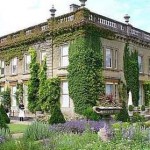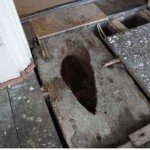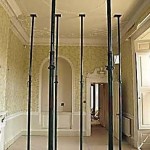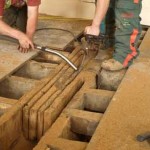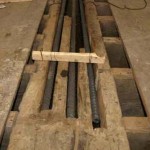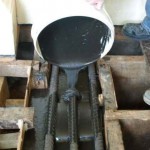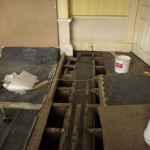Cudahy This case study focused ont he TG6 Timber Grout repairs used to regain the structural integity of floor beams badly affected by decay.
lidir. Kiddington Hall . Oxfordshire, was built in 1673, the parkland being designed by Lancelot ‘Capability Brown’ the 18th Century landscape architect. It is built of honey coloured Cotswold stone.
The entrance and staircase lead to five main reception rooms, which include a Rococo-style drawing room; a morning room; a richly decorated dining room with twin columns and carved marble fireplace; a library with its Neoclassical friezes; and a panelled billiards room that overlooks the gardens.
The main 18th-century staircase leads to two bedroom suites, seven further bedrooms and three bathrooms on the first floor. The back stairs lead to the second floor and ten attic rooms.
As expected in a building of this age, the ravages of damp, infestation, changes of use, have taken their toll on many of the structural elements within the building. Solid oak beams of 400mm x 400m not only supported the upper floors but also supported the ornate decorative ceilings below.
A method of repairing the beams in situ was required to obviate disruption or removal of the underlying decorative ceiling, also to minimise the number of floor boards and coverings to be lifted on the upper floors.
Prior to affecting the repairs to the joists they required to be supported from below by the addition of minimum size holes in the decorative ceiling for the supporting Acrow props. Only small areas of the ceiling required plaster type repair following the main intervention.
The next step in the Rotafix repair methodology, once the beam was supported, was to remove damaged timber. In this case a chainsaw, in conjunction with traditional hand tools, was used to remove damaged timber and to shape the timber ready to receive the reinforcing bars that gave the beams rigidity and increased bending strength.
Up to 9 rebar rods of 25mm diameter 6 metres in length were used to reinforce the repair. Prior to pouring the Rotafix TG6 Timber Grout was essential that the rebar was pre-cleaned and rendered free from corrosion by gritblasting to SA2.5 standard. The TG6 Timber Grout fully encapsulated the rebar and filled voids within the timber beam.
TG6 Timber Grout is free flowing, very searching structural grout. The grout flows up to 6 metres and has a typical open time of 50 minutes at 20°C. The TG6 Timber Grout whilst curing is an exothermic reaction that could see temperatures in the grout rise to 50-60°C. To keep these temperatures to a minimum it is recommended that the material is poured in batches not exceeding 60 litres per individual pour.
Once the TG6 Timber Grout cured the floor boards were replaced. The props remained in place for 7 days after which they were removed and the ceiling restored to its full glory.
Rotafix provide comprehensive training and support for contractors carrying out these types of restoration.
For further information about the Resiwood system of repair, using TG6 Timber Grout, or obtaining species matched replacement timber splice ends manufactured to meet your requirements, please contact us on +44 (0)1639 730481 where one of our technical team will be happy to assist.
